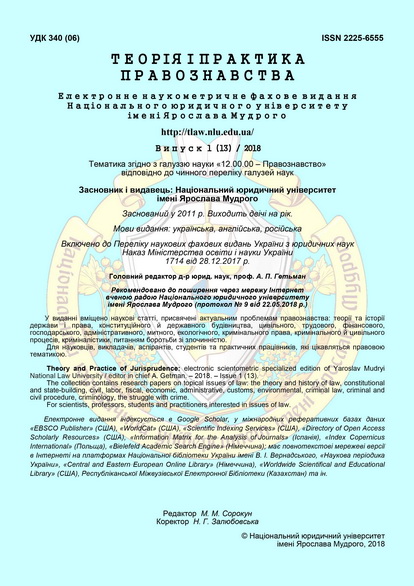Main dysfunctions of the legislation of Ukraine on association of holding type enterprises
DOI:
https://doi.org/10.21564/2225-6555.2018.13.127823Keywords:
economic organization, holding, economic concentration, legal status of large business companies, the legal status of large business companiesAbstract
The experience of developed countries shows that it is the holding company that is one of the most effective organizational and legal forms of the functioning of economic organizations. It is used as a fundamental tool for implementing investment projects and optimizing tax planning, as well as for consolidating international group companies. The relevance of this study, moreover, is seen in the allocation of universal criteria for the selection of holding companies among other legal constructions.
In the modern legal literature, Zadhaylo DV, Lukach IV, Shitkina IS, Plavshuda KV, O. Vinnik, V. Myhaylyuk, S. Grudnytska paid attention to the study of this issue, Stadnik K. and others.
The purpose of this article is to assess the legal regulation of associations of associated enterprises of holding type and optimize the current legislative regulation of the creation and operation of holding companies.
The analysis of the current legislation, namely the Law of Ukraine "On Holding Companies", proves that there are significant gaps and imperfections in its text. As it is seen, the law was adopted to regulate the peculiarities of the creation and operation of, in fact, state-owned companies, created as a result of corporatization and privatization of entire sectors in the national economy.
The legislator did not foresee such a way of forming a holding company as the absorption of one economic entity by another by acquiring a controlling interest in the first one, which is carried out also during the privatization process, as a result of which the acquiring undertaking accepting is recognized as a holding company and absorbed accordingly - subsidiary company. In addition, the question arises as to whether a holding company is a holding if the managing company owns not 100% of the shares of subsidiaries, and for example, 60%. When there is a so-called "net" scheme of formation of the holding. It should be noted that the imperfect legal regulation of the activities of large business entities leads to a decrease in efficiency, and sometimes to make it impossible to control their activities.
Most often, large business organizations are created in the form of mergers of holding companies with an extensive system of corporate (affiliated) enterprises, merged holding company, which is the most effective tool for achieving the strategic and tactical goals of enterprises with a strong concentration of capital.
It is to be noted that the current version of the Law of Ukraine "On Holding Companies of Ukraine" has already exhausted its resources in the process of privatization of the lion’s share of state production assets. The law has historically exhausted or almost exhausted its regulatory potential, and for the regulation of holding relations in the private sector of the national economy, the name of the normative act is in fact not adaptedReferences
Hospodarskyi kodeks Ukrainy: Zakon Ukrainy vid 06.01.2018 r. № 436-IV. (2003.). Vidomosti Verkhovnoi Rady Ukrainy, 18–22, 144.
Pro kholdynhovi kompanii v Ukraini: Zakon Ukrainy vid 15.03.2006 r. № 3528-IV. (2006). Vidomosti Verkhovnoi Rady Ukrainy, 34, аrt. 291.
Pro kholdynhovi kompanii, shcho stvoriuiutsia u protsesi korporatyzatsii ta pryvatyzatsii: Ukaz Prezydenta Ukrainy vid 11.05.1994 r. № 224/94. URL: http://zakon5.rada.gov.ua /laws/show/224/94.
Plavshuda, K.V. (2013). Formuvannia vertykalno intehrovanykh kholdynhovykh struktur u metalurhiinii promyslovosti Ukrainy. Yuryst Ukrainy, 2 (23), аrt. 96–101 [in Ukrainian].
Lazarenko, M.P. (2013). Intehratsiini protsesy korporatyvnykh struktur v systemi ekonomichnykh vidnosyn. Vseukrainskyi naukovo-vyrobnychyi zhurnal, 5, 100 [in Ukrainian].
Lukach, I.V. (2008). Pravove stanovyshche kholdynhovykh kompanii. Kyiv: Yurinkom Inter [in Ukrainian].
Shitkina, I.S. (2006). Pravovoe regulirovanie organizatsii i deyatelnosti holdinga kak formyi predprinimatelskogo ob’edineniya. Extended abstract of candidate’s thesis. Moscow [in Russian].
Khreptak, V.I. Pravovyi status kholdynhovoi kompanii v Ukraini. URL: http://dspace.pnpu.edu.ua/bitstream/123456789/4589/1/Hreptak.pdf [in Ukrainian].
Horbunova, K. Apteky svitu–2017: peretvorennia farmrynku pislia kryzy. URL: https://www.apteka.ua/article/415328?print.
Shomin Mykhailo. Pravovyi status kholdynhovykh kompanii: problemy ta perspektyvy. URL: http://www.justinian.com.ua/article.php?id=2285 [in Ukrainian].
TOP-10 samyihkh dokhodnyihkh aptek Ukraynyi. URL: https://delo.ua/business/top-10-aptechnyh-setej-ukrainy-324373/ [in Russian]
Downloads
Published
How to Cite
Issue
Section
License
Copyright (c) 2018 Theory and practice of jurisprudence

This work is licensed under a Creative Commons Attribution 4.0 International License.




